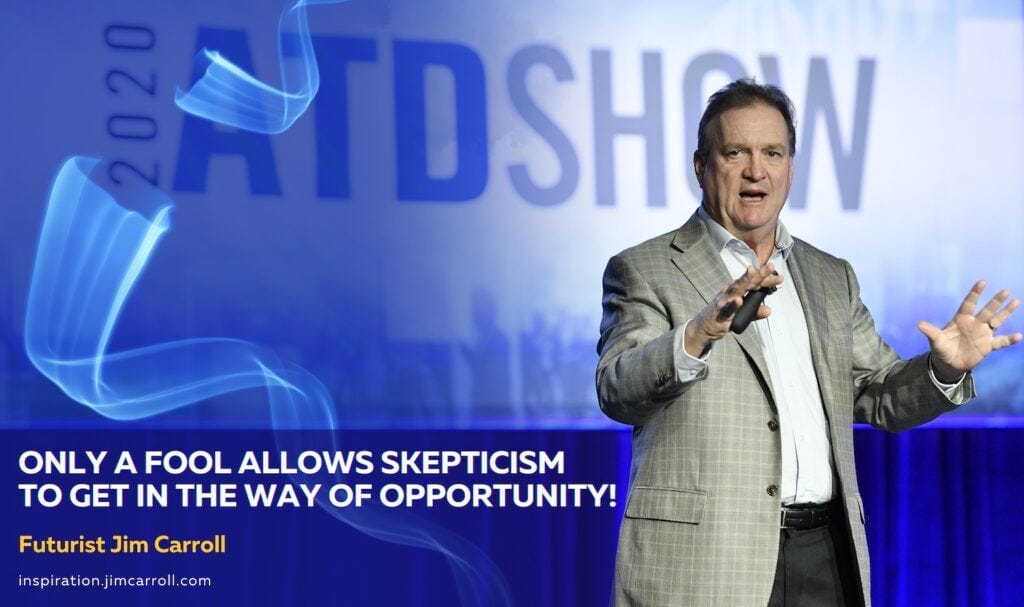"

Let's talk about trucks!
Three years ago today, I had one of my last in-person keynotes before the pandemic hit. In Las Vegas, I was the luncheon speaker for the annual conference of the Association of Truck Dealers, which itself was nestled into the massive National Automotive Dealers Association Conference. I was reminded of this yesterday when keynoting a company that is in the equipment and vehicle leasing industry, with one of my points being that 'the nature of what you lease is changing,' - with trucks and cars essentially becoming big computers on wheels with big batteries.
I remember the situation leading up to my keynote in Las Vegas three years ago. I had already done many, many talks within the trucking and vehicle industry, and skepticism as to whether we might ever see the arrival of electric trucks was everywhere. All kinds of excuses were given throughout the industry - batteries were too heavy, the range would never be achieved, and charging infrastructure was lacking.
Fast forward - skepticism is mostly gone with the major truck companies, and massive investments are well underway. Only a fool lets skepticism get in the way of opportunity!
The need is dire - in Europe, trucks represent less than 2% of all vehicles but 25% of all emissions. In the US, it's 5% of vehicles but 29% of emissions. For those who believe that the climate emergency is real, there is a big problem to solve here - and that group includes most major truck manufacturing companies.
Among the major companies, Volvo seems to be leading the pack - indeed, it's had a fleet of trucks operating in Australia since 2021, and is building out a factory in Brisbane to commit to expanded production, as well as facilities in Europe and America. Telsa is investing $3.6 billion in a battery and electric semi-truck manufacturing facility in Northern Nevada, and Pepsi has already begun to take delivery of some vehicles which first became available late last year. In 2018, Penske formed an initiative with 28 other customers of Daimler to support their electric truck initiative and has begun rolling out electric trucks in the UK.
Corporate and government groups are jumping in. The US Postal Service has committed to buying 66,000 electric vehicles, including trucks, by 2028, as part of President Bidens' infrastructure initiative. Mexcian dairy farm Grupo Lala has a fleet of 30 electric trucks in operation, while DHL is operating 70 such vehicles in Brazil. The aforementioned initiative Pepsi has with Tesla is bold - expect their fleet, as with others like Coke, Amazon, and Walmart to see an aggressive rollout as production ramps up.
The initiative is global - everywhere you look, it's pretty clear that any skepticism is gone, and it's clear that the industry is now heavily invested in the early experimentation and learning phase. Expect this to ramp up quickly.
Range skepticism? People were doubtful that trucks could get the range necessary for economic operation, but the eCascadia from Daimler is typical of what is being produced - it can get 155 to 230 miles of range on a full charge (depending on the steepness of grade) and can haul up to 82,000 pounds. Volvo's ENR Electric can get 275 miles, and Tesla's base model Semi is about 300.
Recharging? Infrastructure investments are soaring. BP Pulse is investing $600 million to build electric charging infrastructure corridors for trucks along a 600km stretch of the busy Rhine-Alpine trucking freight corridor in Germany with high-speed charging. Each location can service 20 trucks at a time and can add 200km in but 45 minutes - which, incidentally, ties into the mandatory rest period for truck drivers as prescribed by European law. It's estimated that Europe will have some 270,000 medium and large-scale electric vehicles in operation by 2030, requiring 140,000 such charging stations.
Indeed, infrastructure in this industry is all about 'freight corridors' - there's an initiative to build such a trucking freight corridor from the busy shipping port of Long Beach, California to El Paso, Texas, with the locations being closely aligned to expected vehicle range and - guess what - mandatory rest stops!
What about the incentive for adoption? The same thing as with electric cars - lower (almost non-existent) maintenance costs and significant savings compared to gas and diesel, Oh, and driver and economic incentives - at the Gothenberg Shipping Terminals in Sweden, electric trucks are given a priority lane and can bypass any lines.
Clearly, we are in the early stages of this trend as the cost for a fully electric semi-truck is still very significant. But as production ramps up and adoption picks up, you can expect the trend to accelerate through the next decade. In ten years, most major fleets will be fully electric. Because skepticism, once it's gone, disappears completely.
Here's a clip from my keynote three years ago today which talked about the issue of timing a trend being critical!
Bottom line? You should never let your skepticism about a trend get in the way of the timing of its arrival!
Futurist Jim Carroll has provided guidance on the future of the electrification of vehicles to such companies as Volvo, Mercedes Benz, Magna, Kalmar Ottawa, and Chrysler. You can learn more at
https://automotive.jimcarroll.com

